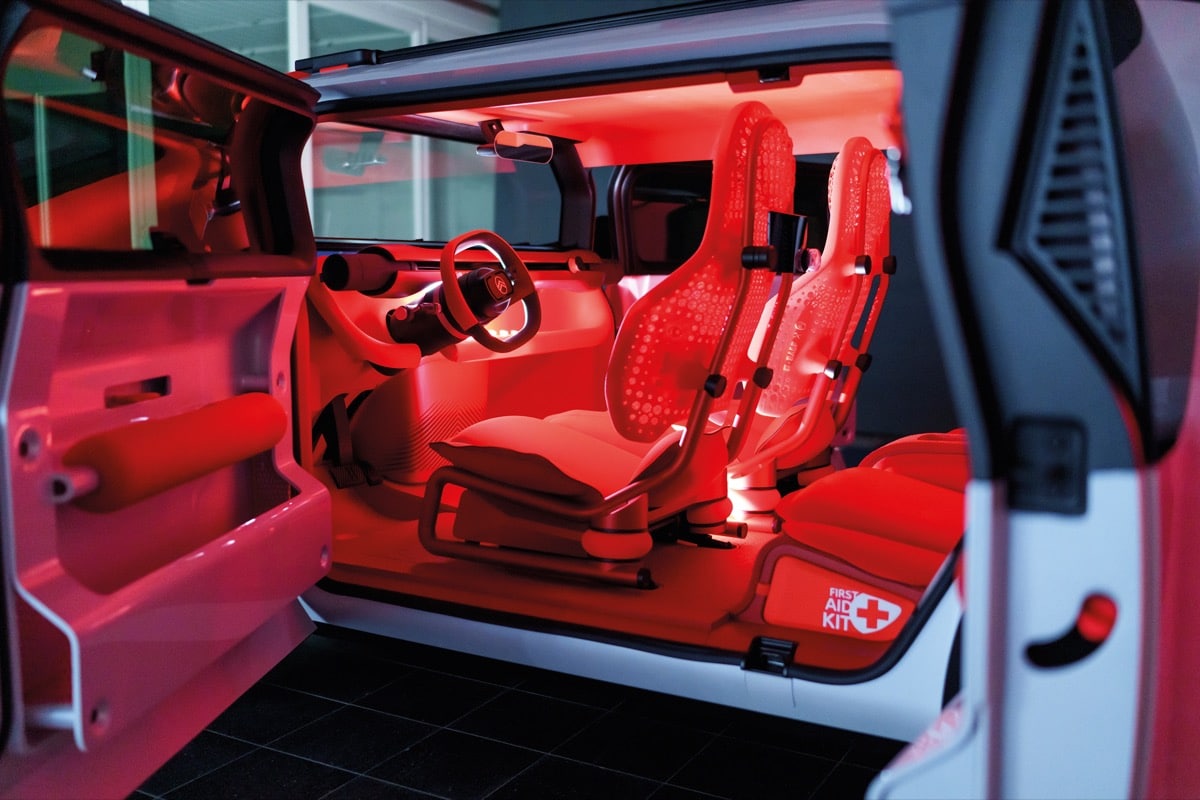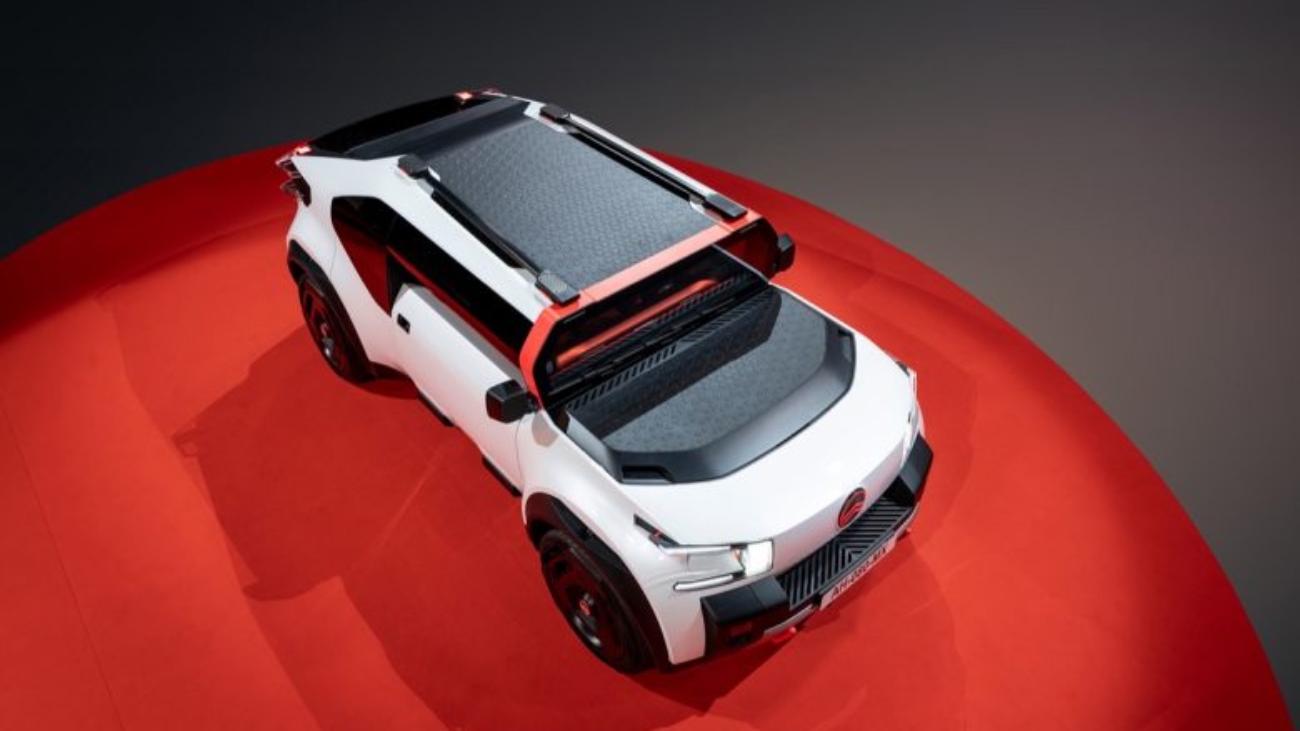It’s no longer about the fastest or most luxurious car. Citroën and BASF have unveiled an all-electric concept car oli [all-ë], as a manifesto on how much can be saved by reducing weight and resource usage. “This concept car shows what can be achieved when partners trust one another and are bold enough to tread new paths,” explained Uta Holzenkamp, President Coatings, representing the automotive team at BASF. “The result is an entire microcosm of ideas and solutions that goes way beyond the original concept.”
With speed limited to 110 km/h (68 mph) and acceleration close to the classic 2CV model, the concept car gains a wider range and significantly improved battery lifespan. The minimalistic approach paved the way for a refreshing and innovative design. Various components have been radically reinterpreted and constructed by using materials in different contexts. For example, the complete backrest is made of a flexible 3D printed plastic material (Ultrasint TPU88A). The open lattice structure provides natural air flow, replacing all ventilators in the seat. For this, as well as to produce about twenty parts the competence of the 3D printing service office, Sculpteo in France, a brand of BASF, was used. And don’t bother looking for a sound or navigation system, because you won’t find one. After all, most customers have a mobile phone and portable speaker, which can be plugged in to the dashboard and automatically connected to the vehicle.
Reduced complexity, increased sustainability
Another striking feature of the Citroën and BASF oli concept is that many of the new components are designed and manufactured from materials from the same chemical product family. Bonded and welded components made from different materials are a challenge in mechanical recycling. For this reason, the designers created as many components as possible from a single material.
This principle of simplicity was also implemented during production. With the driver and front passenger doors being identical, this saves on pressing tools and reduces complexity. The same applies to all wheel arches and bumpers. The oli concept car is proof of the fact that sustainability and an appealing design are not contradictory.
The color of the body perfectly conveys the concept of the car. At first glance, it seems to be pure white color, but mica particles have been added to emphasize the shape of the car. In contrast to the exterior, the materials of the interior – such as the seats and the flooring – have been coated with an intense orange color.

Co-creation as a key to new solutions
The automotive manufacturer Citroën and BASF worked closely during development and design. Innovative solutions from the chemical company played a vital role in this co-creation endeavor. “Projects such as the development of the concept car together with Citroën are a big boost on our way towards a more sustainable future,” explained Uta Holzenkamp. “You need innovation and creative minds to bring the ideas from the different companies together.” BASF has been pursuing an ambitious sustainability strategy for years now. Some of the major cornerstones of this strategy include the ChemCyclingTM project on improving the chemical recycling of plastics, as well as the biomass balance approach, in which fossil resources are replaced with renewables in production.
Manufacturing on Demand
In addition to its product and engineering expertise, BASF was also able to contribute its design expertise through the Creation Center. “This is where the project was born,” said Alex Horisberger, Manager Industrial Design at BASF. “On a visit to the creative studio at Citroën, we were able to convince their designers with our materials and trend analyses. Working on the same level with Citroën’s interior and exterior designers was a personal highlight for me.”
Laurence Hansen, Citroën Product & Strategy Director, sees the collaboration in a similar light. “The collaboration with BASF was a key factor in the design of oli and in developing an electric vehicle that’s as fun and efficient as possible for the near future. The innovative electric car runs counter to the trend toward increasingly heavier and more complex vehicles, instead focusing on ease and simplicity. It demonstrates how to keep environmental impact to a minimum while bringing back the fun of a functional, electric vehicle,” Hansen said.
BASF material solutions
Many BASF automotive solutions help implement this idea: Another high-performance plastic from BASF can be found in the rear armrests and the interior floor. Infinergy, an expanded thermoplastic polyurethane (TPU), is also used in running shoes and sports flooring. It is elastic like rubber, but lighter, robust, and highly resistant to abrasion. In oli, the material provides a pleasant yet stable surface in armrests and floors. Plus, it dampens noise and vibrations. Additionally, a special coating is applied to ensure an extra long life span. The water-based NovaCoat-P coating is ideal for protecting soft substrates against abrasion, UV radiation, dirt, and chemicals. And because the flooring is waterproof, it can be easily cleaned with water. This is where the integrated plugs made of Elastollan come in handy, as they can be removed to drain water and dirt.
The weight of the vehicle exterior was also considerably reduced, while at the same time increasing stability and durability. The hood, roof, and trunk are made of panels combining the Elastoflex® polyurethane system and the Elastocoat® spray paint system. Thanks to the honeycomb sandwich structure, these panels are so stable that you can even stand on them. This is part of the vehicle’s functionality.
Used for coating the car body, R-M AGILIS is another BASF product that provides greater sustainability. The water-based coating has a very low content of volatile organic compounds (VOCs).
BASF CathoGuard 800 electrocoat, which protects the battery housing from corrosion, contributes to further resource savings. It stands out for its high performance and eco-friendliness as it is tin/HAPs-free and with low solvent content.
You might also like:
Velo3D qualifies M300 tool steel for use in Sapphire printers: “By qualifying M300 tool steel for use in our printers, we’re able to service entirely new industries, like automotive and tooling, that can leverage Velo3D’s advanced capability to print high quality, large diameter internal channels for their applications,” said Greg Brown, VP of Technology at Velo3D. “By manufacturing die cast inserts and other tooling components with our technology, we expect companies will be able to build stronger products, improve machining throughput, and decrease manufacturing costs.”
* This article is reprinted from 3D Printing Media Network. If you are involved in infringement, please contact us to delete it.
Author: 3D Printing Media Network


Leave A Comment